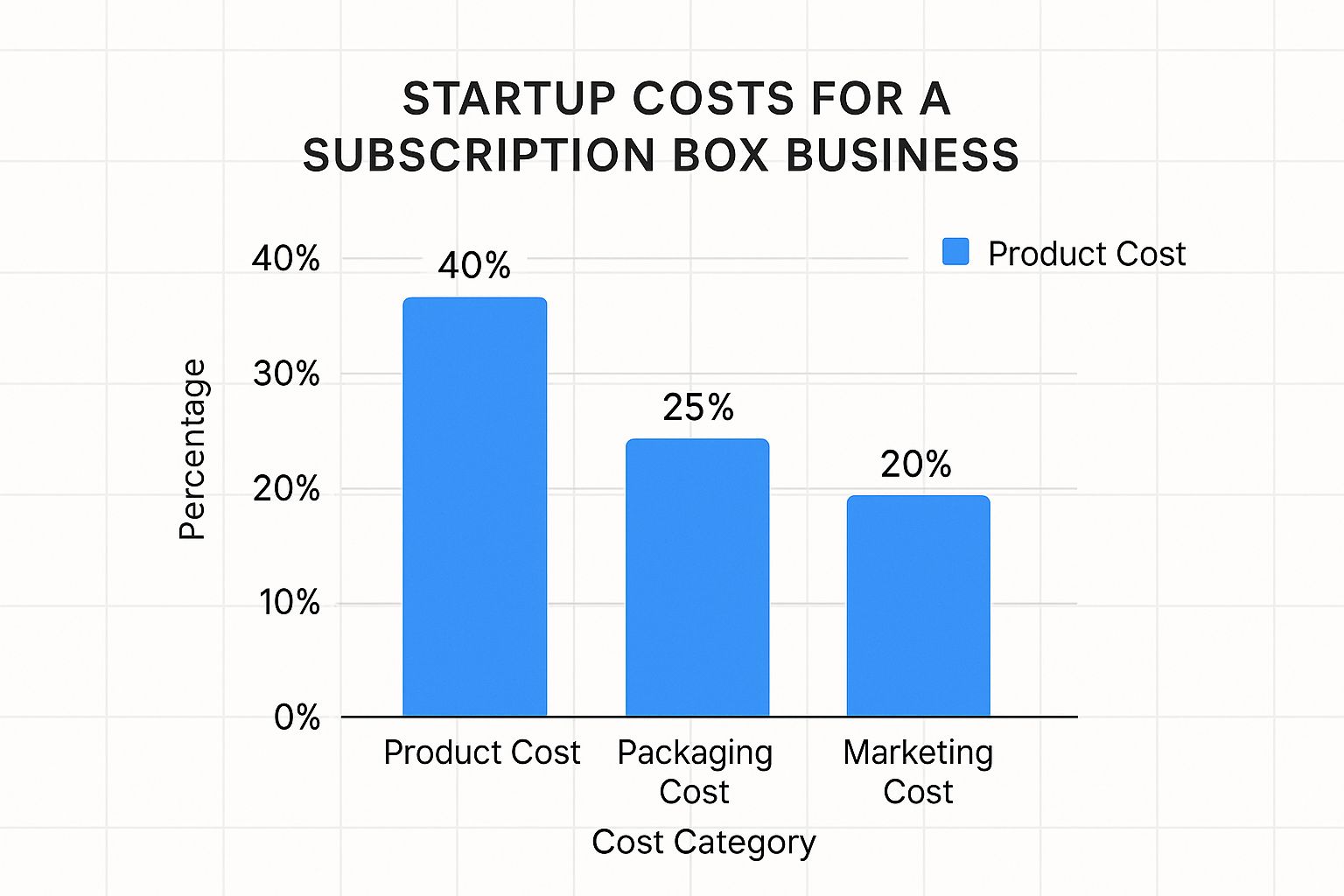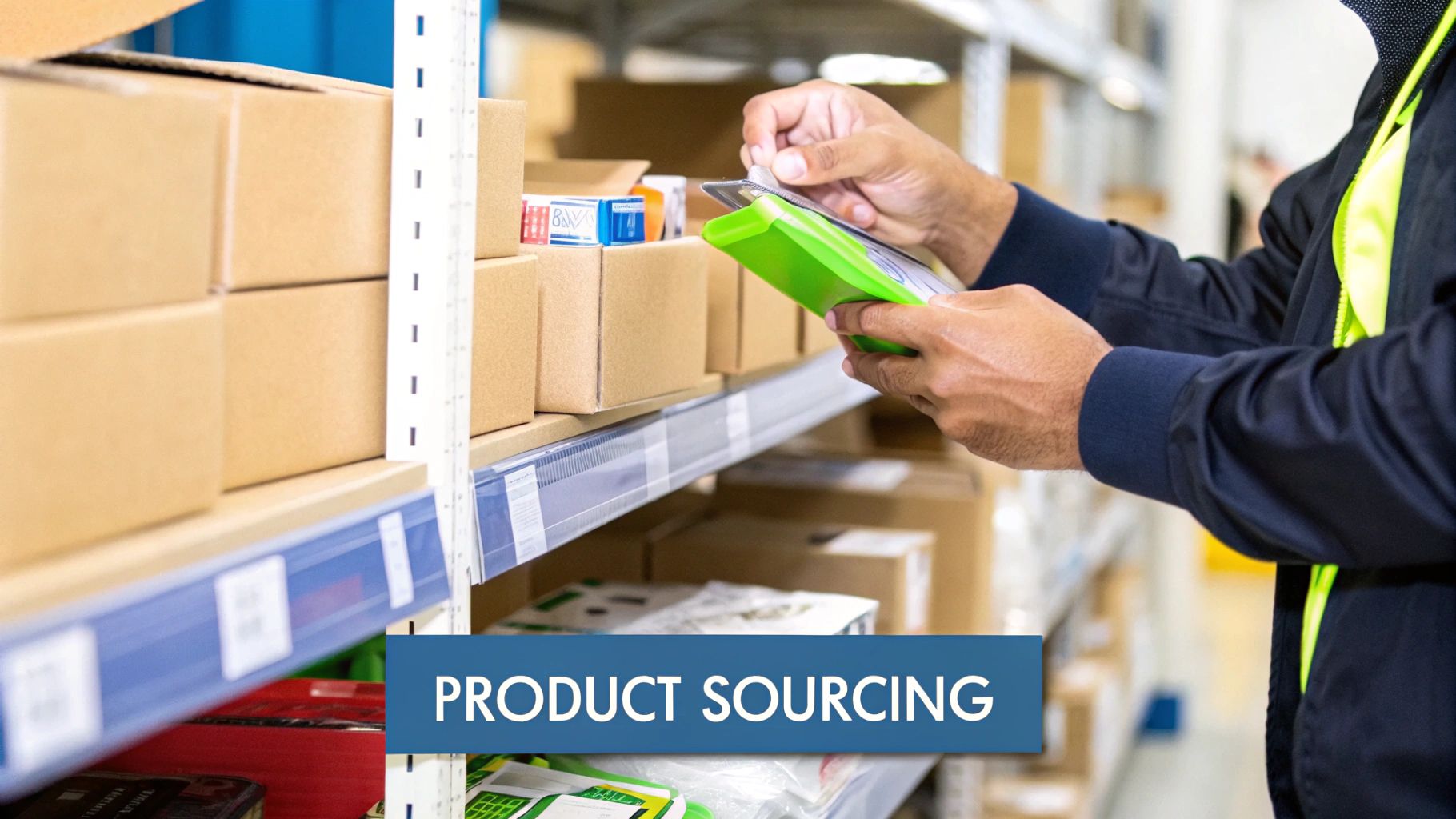Starting a subscription box business isn't a single project; it’s really a series of five key stages: validating your idea, sourcing products, building your brand and tech, mastering fulfillment, and finally, launching your marketing.
Getting this right is about creating a repeatable, exciting experience that builds a loyal community. You're not just aiming for a one-time sale.
Before you even think about printing shipping labels, it's critical to understand why this business model works so well. Learning how to start a subscription box business is less about simply selling products and more about building a predictable, recurring revenue stream.
For customers, the appeal is a powerful combination of convenience, the thrill of discovery, and a deep sense of personalization. It’s no surprise the industry continues to see such strong growth.
The market's potential is undeniable. In 2024, the global subscription box market hit an estimated USD 37.5 billion, a number fueled by a massive consumer shift toward curated experiences delivered right to their doors. And this trend is only picking up speed. Forecasts project the market will nearly triple to a staggering USD 116.2 billion by 2033. You can dig deeper into these numbers by checking out the full market report on IMARC Group. This data isn't just encouraging; it confirms you're stepping into a thriving industry, not a passing fad.
Most successful subscription boxes fit into one of three main categories. Figuring out which one you are helps define your entire approach and how you present your value to customers.
Here's a quick breakdown of the primary models to help you decide which one best fits your big idea.
As you can see, your choice here has a ripple effect on everything else. A curation model sells the experience of discovery, while a replenishment box sells pure convenience. Make sure your operations, from sourcing to marketing, are perfectly aligned with the core value you promise to deliver.
Key Insight: Your chosen model dictates everything from product sourcing to marketing. A curation box sells the experience of discovery, while a replenishment box sells convenience. Align your operations with the core value you promise to deliver.
When you start mapping out your finances, it’s helpful to see a clear picture of where the money typically goes. This chart breaks down the major cost centers you can expect when launching a new subscription box business.

It’s pretty clear from this breakdown that the physical product itself is your single largest expense. This really underscores how important it is to get your sourcing and supplier negotiations right from day one. After that, packaging and marketing represent the next biggest investments you'll need to make to get off the ground successfully.

The success of your entire subscription box business really boils down to two things: the niche you choose and the products you put in the box. A brilliant idea won't get you far without a passionate, underserved audience. And a great audience will vanish if your products don't consistently delight them.
Your journey to a must-have box starts right here.
Forget about broad ideas like a generic "snack box" or a "beauty box." That market is completely saturated. Your real path to building a profitable business is through specificity. Think about communities built around a shared passion, a specific hobby, or a lifestyle. These are the people who will not only subscribe but become your biggest fans.
For instance, instead of a general "book box," what about "vintage sci-fi paperbacks" or "indie graphic novels by female artists"? Instead of another "pet box," you could zero in on "eco-friendly toys for large-breed dogs" or "gourmet, grain-free treats for cats with allergies." These focused concepts resonate deeply because they make a specific group of people feel seen and understood.
Before you spend a single dime on inventory, you have to validate your idea. An idea is just an idea until you can confirm people will actually pay for it. The goal is to find that sweet spot: an audience passionate and large enough to build a business on, but not so broad you're clashing with the industry giants.
Start by digging into the online communities where your potential customers are already hanging out.
This early research isn't just about validating your idea; it’s about learning the language your audience uses. That insight is gold for your future marketing.
Expert Tip: Don't just be a lurker in these online spaces. Actually engage. Ask questions like, "What's the one product you wish was easier to find?" The answers you get can directly shape your sourcing strategy and tell you if you're on the right track.
Marketplaces like Cratejoy are also fantastic for a quick reality check. You can see what's already out there, spot potential gaps in the market, and get a feel for what customers are currently paying for similar boxes.

Looking at the competition this way shows you how they position themselves with branding, pricing, and product choices—all critical clues for how you can make your own box stand out.
Once you've confirmed your niche has potential, the real fun begins: the treasure hunt for products. Sourcing is a constant process of discovering unique, high-quality items that fit your brand's theme and, just as importantly, your budget. This is where you build your reputation.
There are a few main ways to go about it.
Wholesale SuppliersThis is the most well-trodden path. You buy products in bulk from distributors or directly from brands at a wholesale price. Platforms like Faire and Abound are great for this, connecting you with thousands of independent brands that are perfect for subscription boxes. When you're talking to suppliers, don't forget to mention that your order volume will grow as you get more subscribers—that can be a powerful negotiating tool.
Artisans and Small MakersSourcing directly from small-batch creators on sites like Etsy or even at local craft fairs can give your box an exclusive, handcrafted feel. This approach doesn't just get you unique products; it builds a compelling story and lets you support other small businesses. Forging personal relationships with these makers is key.
Manufacturing Your Own ProductsIf you have a truly unique product idea, you can work with a manufacturer to bring it to life. This gives you the ultimate control over your brand, but it also comes with the biggest upfront investment and the headache of managing a more complex supply chain.
Finding the right sourcing partners is absolutely essential for keeping your quality high and your deliveries reliable. For a deeper dive into building your supplier network, check out our guide on ways to find the best subscription box suppliers.
No matter which route you take, always, always get samples before placing a big order. Something can look amazing online but feel cheap and flimsy in your hands. Your subscribers are trusting your taste, so every single item has to pass your quality check. This is what turns a simple box of stuff into an experience people can't wait to receive each month.
The demand for these kinds of specialized goods is exploding. The North American subscription box market, for example, is projected to grow at a CAGR of 16.8% through 2034, showing just how much opportunity there is for well-curated boxes that truly nail their niche.
Alright, you've nailed down a promising niche and have a plan for sourcing your products. Now it’s time for the fun part—building the two engines that will power your business: your brand and your technology.
A killer brand makes people want your box, while the right tech makes it possible to deliver on that promise without pulling your hair out. Get these two right, and you're well on your way.
Let's be clear: your brand is way more than just a cool name and a logo. It’s the whole vibe. It's the story you tell and the feeling someone gets when they see your box arrive on their doorstep.
For a subscription box, the brand comes to life in the physical experience. That unboxing moment? It’s your Super Bowl. It's the single most powerful marketing opportunity you have, period.
Think of your packaging as your best salesperson, not just a necessary cost. It's the first tangible thing a customer touches. A plain brown box with stuff rattling around inside feels like a transaction. A beautifully designed, custom-branded box with carefully placed products feels like a gift. It's an experience.
Key Takeaway: The unboxing experience is where your brand story becomes real. Invest in quality packaging, maybe some branded tissue paper, or even a small printed card that shares the story behind the month's curation. This is the stuff that gets shared on Instagram and creates that word-of-mouth buzz every founder dreams of.
With a strong brand vision in place, you need the right tools to execute it. Your tech stack is the central nervous system of your operation, handling everything from your website to the nitty-gritty of recurring payments. Picking the right platform now will save you a world of hurt later.
The big choice you'll face is between an all-in-one platform and a more flexible e-commerce platform paired with a subscription app.
I almost always recommend the second option. It gives you total freedom. You can sell one-off products, tap into the massive Shopify app ecosystem, and have complete control over your website's look and feel.
Here’s a glimpse of the Recharge interface, which bolts onto platforms like Shopify to run your subscription engine.
This dashboard gives you an instant pulse on your business's health—you can see your active subscriber count and monthly recurring revenue at a glance. That kind of real-time data is absolutely vital for making smart decisions as you grow.
Whatever platform you land on, don't get sidetracked by flashy features you'll never use. Make sure it has these three essentials nailed down. They are non-negotiable.
Putting together your operational framework is a huge step, and your fulfillment strategy is a massive piece of that puzzle. For a deep dive into getting your products picked, packed, and shipped efficiently, our subscription box fulfillment mastery guide lays out the entire blueprint.

You’ve nailed the branding and found incredible products. Now comes the hard part—the unglamorous work of logistics that actually gets your box into a customer's hands.
Fulfillment and shipping are the operational backbone of your business. Get this right, and you build a loyal following. A single miscalculation here, though, can wipe out your margins and turn a fantastic unboxing experience into a frustrating wait.
This is where the physical meets the financial. Every choice, from the weight of your box to the tape you use, has a price tag. Your mission is to create a seamless, reliable process that delivers a perfect box every single month without eating all your profits.
One of the first major forks in the road for any subscription box founder is deciding who will pack the boxes. Will it be you, or a professional company? Both paths have real advantages depending on your scale and resources.
Self-Fulfillment (The DIY Approach)Most founders start out packing boxes in their living room or garage. This hands-on method gives you absolute control over quality and the final presentation.
Outsourcing to a 3PL (Third-Party Logistics)A 3PL is a partner that stores your inventory, assembles your boxes (a process called kitting), and ships them for you. This is how you scale.
Expert Insight: The classic path is to start by fulfilling in-house to master the process and keep costs rock-bottom. The trigger to switch to a 3PL usually happens when you realize you're spending more time with a tape gun than on marketing, or when you physically can't fit another case of products in your garage.
Shipping is one of the biggest and most volatile expenses you'll have. If you underestimate it, you could lose money on every single box you ship. Nailing this is a non-negotiable part of building a successful subscription box business.
Your shipping cost boils down to three main factors:
To protect your profits, you have to research shipping rates before you finalize your box price. Use the online calculators from major carriers to run estimates for various zip codes. A common strategy is to charge a flat shipping fee to customers that represents a blended average of your actual costs.
For a deeper dive, check out our guide on the secrets to cheaper subscription box shipping.
When you're ready to outsource, picking a 3PL is a decision that will directly affect your brand's reputation. Not all fulfillment centers are the same, especially when it comes to the unique demands of subscription boxes.
Before you even think about signing a contract, you need to ask some critical questions:
Finding a partner who understands the monthly rhythm of a subscription business—with its predictable, intense rush—is the key to a scalable and stress-free fulfillment operation.

You can have the most amazing subscription box in the world, but it won’t sell itself. If nobody knows it exists, it might as well not. This is where the real work begins. Let's build your go-to-market playbook, cutting through the fluff to focus on high-impact strategies that will land you those crucial first subscribers and build real momentum from day one.
Your launch doesn't start on launch day. It begins weeks, sometimes even months, before with a solid pre-launch campaign. The absolute centerpiece of this effort is a simple "coming soon" landing page with one job: to capture email addresses. This isn't just about building a mailing list; it's about curating a group of your most enthusiastic, ready-to-buy future customers.
Give them a compelling reason to hand over their email. An exclusive "founder's discount" or a free bonus item in their first box are classic, effective tactics. This creates urgency and makes people feel like insiders, turning passive interest into active anticipation. As your list grows, you need to nurture it with regular updates, behind-the-scenes content, and sneak peeks of the incredible products you're sourcing.
While your pre-launch email list is growing, it's time to build social proof. For a brand-new subscription box, nothing beats authentic, third-party validation. This is where micro-influencers are your best friend.
Micro-influencers, who typically have between 1,000 to 100,000 followers, are a game-changer. They offer a powerful, affordable alternative to a big-budget celebrity endorsement. More importantly, they often have highly engaged, niche audiences who genuinely trust their recommendations. Because they're smaller, they're also far more accessible—many will happily review your box in exchange for a free prototype.
Your outreach needs to be surgical. If you're launching a box for eco-conscious dog owners, a general pet influencer is fine, but one who specifically champions sustainable pet products is pure gold. Personalize every single email and explain exactly why your box is a perfect fit for their personal brand and their audience. This approach generates those authentic unboxing videos and posts that feel like a real recommendation, not a paid ad.
Key Takeaway: Unboxing videos are marketing gold. A single, genuine video from a trusted micro-influencer can be more persuasive than a dozen polished ads. It provides an unbiased look at your products and showcases the unboxing experience you've worked so hard to perfect.
Organic efforts will get you started, but targeted advertising is how you pour fuel on the fire. For new subscription boxes, platforms like Facebook and Instagram are ideal because of their incredibly powerful targeting tools. You can build audiences based on specific interests, online behaviors, and even people who have engaged with brands similar to yours.
Start small. Your initial goal isn't to get thousands of subscribers overnight; it's to gather data. Run a few different ad creatives, test various headlines, and experiment with different audience segments to see what sticks.
As soon as you start spending, you absolutely must track your Customer Acquisition Cost (CAC). This metric is non-negotiable. It's simply your total marketing spend divided by the number of new subscribers you gained. If you spend $200 on ads and get 10 new subscribers, your CAC is $20.
Knowing this number is the foundation of a profitable business. You can then compare your CAC to your customer's lifetime value (LTV) to ensure your marketing engine is actually sustainable and not just burning cash.
To help you decide where to put your initial ad budget, here’s a quick comparison of the most common channels for a launch.
Each channel has its place, but a mix of micro-influencers for credibility and targeted social ads for reach is often the winning combination for a new subscription box.
While this all focuses on getting new customers, remember that keeping them is where the real profit is made. Customer retention is massive in the subscription world. In the fashion box sector, for example, data shows that about 45% of subscribers stick around for over a year. That loyalty is what creates the predictable, recurring revenue you need to grow.
Ultimately, your marketing and retention efforts are two sides of the same coin. They feed directly into a healthy, scalable business model. For a deeper dive, check out our full guide on how to create a successful subscription model.
Diving into the subscription box world is exciting, but it naturally brings up a lot of questions. Beyond the big-picture strategy, I’ve seen countless new founders wrestle with the same practical hurdles around money, legal stuff, and keeping customers from canceling. Getting a handle on these concerns is a huge part of learning how to build a subscription box business that actually lasts.
Let's break down the three most common—and critical—questions that come up time and time again.
This is the big one, and the only honest answer is: it depends. A super lean, bootstrapped launch can get moving for under $1,000. But if you're aiming for a more polished start with custom packaging and a decent amount of inventory, you could easily be looking at $5,000 to $10,000 or more.
Your starting budget really comes down to a few key decisions you have control over:
To put together a realistic budget, you absolutely must account for these core startup expenses:
For most people, a practical budget for a professional-looking, small-scale launch lands somewhere in the $2,000 to $5,000 range. This gives you enough runway to create a quality experience from the start without taking on a scary amount of financial risk.
Two major pitfalls can torpedo a new subscription box business before it even has a chance to float: ignoring sales tax and completely mismanaging cash flow. They aren’t exciting topics, but getting them wrong is a fast track to failure.
First, let's talk sales tax. It's complicated, but it's not optional. You're required to collect and pay sales tax based on "nexus"—which is basically a connection between your business and a state. This can be triggered by having a physical presence (like inventory stored in a 3PL warehouse) or by hitting certain sales thresholds. The rules are different in every state.
Critical Advice: Do not even think about trying to manage sales tax manually. Use your e-commerce platform’s built-in tax tools (Shopify’s are excellent) or integrate a dedicated service like TaxJar from the very beginning. Messing this up can lead to a nightmare of back taxes and penalties.
The second killer mistake is not knowing your numbers. So many founders get swept up in the excitement of revenue but fail to track the costs that are quietly eating away at their profits. You must have a crystal-clear understanding of your Cost of Goods Sold (COGS), which includes the cost of the products, the box, all the packaging, and any fulfillment expenses.
A classic rookie error is underpricing the box, creating a business model that’s impossible to sustain. You absolutely have to build a detailed financial forecast before you launch. This ensures your price leaves a healthy profit margin after every single cost is subtracted.
In the subscription game, great customer service isn't just a bonus—it's your most powerful tool for keeping customers. Churn, the rate at which subscribers cancel, is the silent killer of this business model. Your mission is to keep that number as low as humanly possible by building an experience that feels like more than just a monthly delivery.
Proactive, transparent communication is everything. If a shipment is going to be late, get out in front of it and tell your customers. Make it ridiculously easy for people to get in touch with you if they have a question or an issue.
To actively fight churn, focus on giving your subscribers more control and building value that goes beyond the products in the box.
A little bit of churn is normal and expected. But a consistently high churn rate is a massive red flag. It’s a clear signal that there's a mismatch between what your customers expect and what your business is actually delivering. By focusing on these proactive strategies, you can build a loyal tribe of subscribers who feel like they're part of something special, not just another name on a shipping list.
When you're ready to scale and need a partner who understands the unique demands of subscription box fulfillment, Simpl Fulfillment can help. We provide fast, reliable, and brand-focused logistics so you can concentrate on growing your subscriber base. Learn more about our specialized subscription box services.